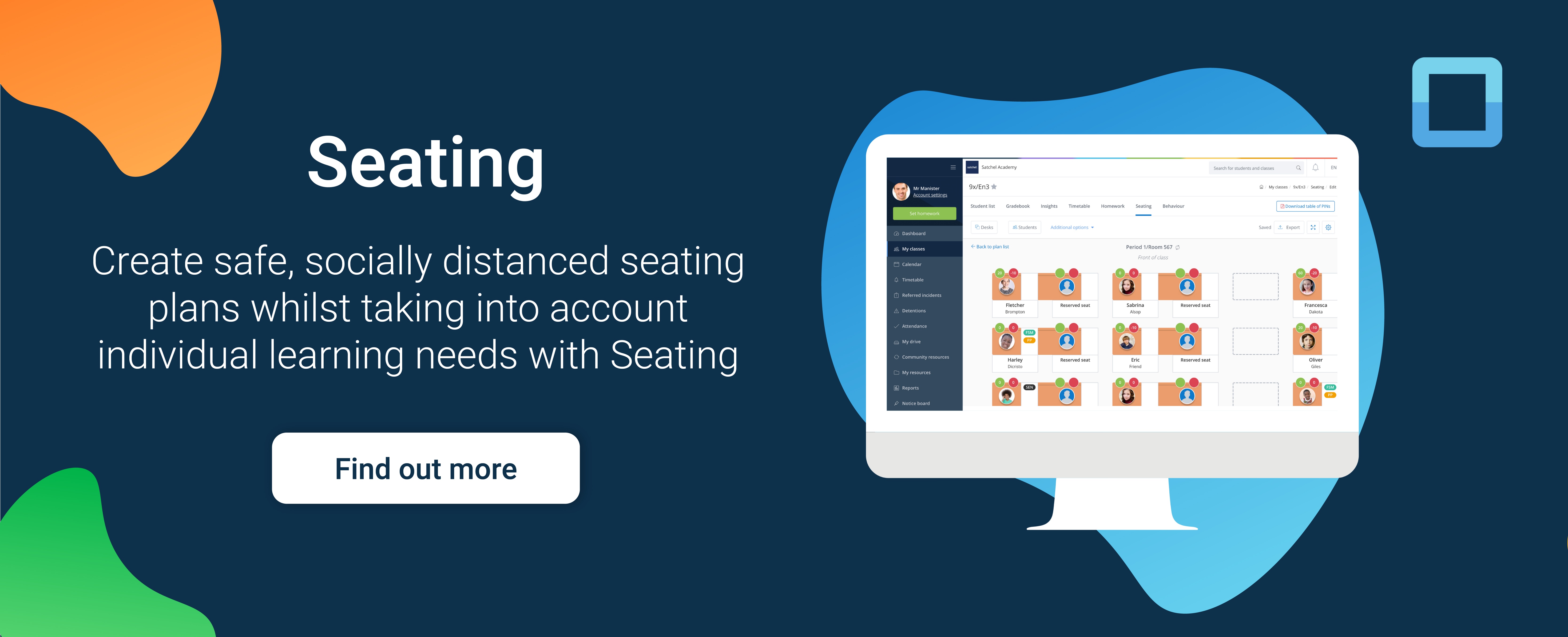Author: Bethany Spencer
Posted: 06 Mar 2018
Estimated time to read: 4 mins
There’s more to a student’s academic success than just great teaching and great content; the environment in which they learn has a major impact on their progression.
Effective classroom management plays a huge role in this and includes class seating plans. How and where students are seated can have a positive impact on student behaviour, academic performance and class participation.
Studies have also found that students perform better in seats that are allocated to them as opposed to choosing where they sit themselves.
What are the effects of having seating arrangements in the classroom?
The use of seating plans in the classroom supports teachers in their overall management of the classroom and further supports students’ learning. A well thought out and considered seating arrangement should take into consideration the layout of the classroom, groupings of students and their inclusion data to create the optimum learning environment.
Benefits of seating arrangements include:
- Improved classroom management
- Well-behaved students
- Students’ individual needs catered for
- A classroom that reflects a teacher’s teaching style
- Safe and accessible classroom environment
The role of seating plans in classroom management
Effective classroom management is more complex than just creating a seating arrangement for your students, but we do identify seating plans as one of the core pillars of good classroom management.
Classroom seating plans allow teachers to exert a level of control over their students. By constructing their classroom and making informed decisions on where their pupils sit, they can take actions to solve problems before they occur - for example, not seating two chatty best friends next to each other or placing the student who is visually impaired at the front of the class.
Additionally, assigning seats to your students can set the tone that you are the teacher and in control as soon as they set foot in class.
The impact of seating plans on student behaviour
If you’re experiencing issues with poor student behaviour and you haven’t yet tried a seating plan, we would advise you do. Simple actions like separating the students who don’t like each other and not pairing the chattiest groups together can help minimise low-level classroom disruptions and control noise levels.
Additionally, the way in which you choose to layout your classroom has an impact on student behaviour - cluster groupings make it easier for students to chat and angle themselves away from the board, whereas rows ensure students’ eyes are on you.
These steps should also be applied to any classroom that does have a seating plan and is experiencing some behavioural issues. Usually, seating plans will need to be tweaked throughout the year as students’ relationships, attitudes and personal lives can change which may impact the way in which they behave and interact with their peers - all of which influence their behaviour.
It’s important to remember that seating plans are a work in progress due to the very nature of students and to not get disheartened if you need to mix yours up.
Supporting individual student needs through seating arrangements
By looking at your students’ inclusion data and personal learning needs, you can help to create a class seating plan that builds a learning environment whereby their personal needs are supported and their learning thrives.
Student data and information that should be considered include medical issues - does this pupil need to be seated somewhere specific to support their medical needs? Are they partially sighted and need to sit close to the board? Does this child need to be close to the exit in order to discreetly leave the room if they become overwhelmed?
The personality of students should also be considered - if a pupil is exceptionally shy and you want to encourage them speaking up, consider placing them next to a student who answers questions in class and is encouraging so they can support their peer.
Additionally, if you have a mixed ability group this may include putting the lower achieving students with someone who is performing at a higher level in a bid to motivate the lower achiever, whilst encouraging the higher achiever to consolidate learning through explanations.
Finding a seating arrangement that suits your style
As a teacher, the way in which your tables are organised are not only important to your students and their learning - they’re also important to you, your pedagogy, teaching style and what you want to elicit from your class.
When creating the layout of your classroom consider what you want your class to look like - do you want students to collaborate with each other in groups or do you want a room that facilitates discussion?
Also consider your movement in the class - when you’re teaching, do you walk around the room a lot, or do you primarily teach from the front of the class?
These factors will influence the layout of your classroom - for collaborative classrooms, cluster tables are best, a horse shoe shape for discussion and for teachers who like independent working, rows that face the front of class are preferable.
In order to teach effectively both the students’ and the teacher’s needs need to be catered for.
Ensuring your seating plans are safe
As in any classroom, the safety of students should be of utmost importance and the seating layout in secondary school and primary school will impact this.
In order to ensure a safe and secure classroom there should be enough walking room in your classroom for students to file in and out of class without risk of tripping and away from any hazards. Also, make sure that no fire exits are blocked.
Additionally, given the current climate, it’s important to ensure that any seating arrangements created during the reopening of schools are socially distanced to ensure the safety of students and staff.



